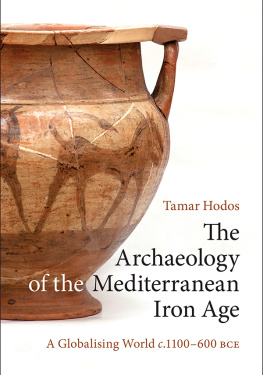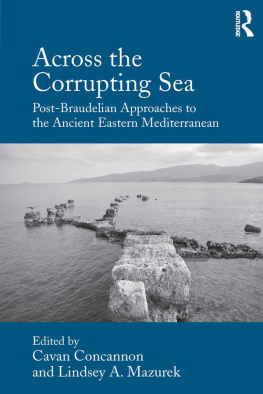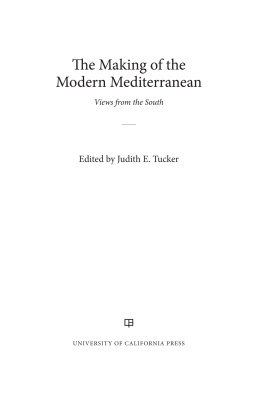The Mediterraneans Iron Age period was one of its most dynamic eras. Stimulated by the movement of individuals and groups on an unprecedented scale, the first half of the first millennium BCE witnesses the development of Mediterranean-wide practices, including related writing systems, common features of urbanism, and shared artistic styles and techniques, alongside the evolution of wide-scale trade. Together, these created an engaged, interlinked and interactive Mediterranean. We can recognise this as the Mediterraneans first truly globalising era. This volume introduces students and scholars to contemporary evidence and theories surrounding the Mediterranean from the eleventh century until the end of the seventh century BCE to enable an integrated understanding of the multicultural and socially complex nature of this incredibly vibrant period.
Tamar Hodos is Reader in Mediterranean Archaeology at the University of Bristol. She is a world-leading authority on the archaeology of the Mediterranean's Iron Age. She is the author of Local Responses to Colonisation in the Iron Age Mediterranean (2006), co-editor of Material Culture and Social Identities in the Ancient World (2010), and The Routledge Handbook of Archaeology and Globalization (2018).
University Printing House, Cambridge CB 2 8 BS , United Kingdom
One Liberty Plaza, 20th Floor, New York, NY 10006, USA
477 Williamstown Road, Port Melbourne, VIC 3207, Australia
314321, 3rd Floor, Plot 3, Splendor Forum, Jasola District Centre, New Delhi 110025, India
79 Anson Road, #0604/06, Singapore 079906
Cambridge University Press is part of the University of Cambridge.
It furthers the Universitys mission by disseminating knowledge in the pursuit of education, learning, and research at the highest international levels of excellence.
www.cambridge.org
Information on this title: www.cambridge.org/9780521199575
DOI: 10.1017/9780511979316
Cambridge University Press 2020
This publication is in copyright. Subject to statutory exception and to the provisions of relevant collective licensing agreements, no reproduction of any part may take place without the written permission of Cambridge University Press.
First published 2020
Printed in the United Kingdom by TJ International Ltd, Padstow Cornwall
A catalogue record for this publication is available from the British Library.
Library of Congress Cataloging-in-Publication Data
Names: Hodos, Tamar, author.
Title: The archaeology of the Mediterranean Iron age / Tamar Hodos.
Description: New York : Cambridge University Press, 2020. | Includes bibliographical references and index.
Identifiers: LCCN 2020009133 (print) | LCCN 2020009134 (ebook) | ISBN 9780521199575 (hardback) | ISBN 9780521148061 (paperback) | ISBN 9780511979316 (epub)
Subjects: LCSH: Mediterranean RegionAntiquities. | Mediterranean RegionEmigration and immigrationHistoryTo 1500. | Mediterranean RegionEconomic conditions. | UrbanizationMediterranean RegionHistoryTo 1500. | WritingMediterranean RegionHistoryTo 1500. | Iron ageMediterranean Region. | Mediterranean RegionHistoryTo 476.
Classification: LCC DE 60 . H 627 2020 (print) | LCC DE 60 (ebook) | DDC 937/.01dc23
LC record available at https://lccn.loc.gov/2020009133
LC ebook record available at https://lccn.loc.gov/2020009134
ISBN 978-0-521-19957-5 Hardback
ISBN 978-0-521-14806-1 Paperback
Cambridge University Press has no responsibility for the persistence or accuracy of URLs for external or third-party internet websites referred to in this publication and does not guarantee that any content on such websites is, or will remain, accurate or appropriate.
For JPL
Contents
Illustrations
Preface
This book is about the interconnections between populations and communities living around the Mediterranean during the early first millennium BCE. This is not the first period in which people across the sea were connected with one another, exchanging goods, ideas, values, customs, practices and technologies. The difference is the scale to which these exchanges occurred at this time. A connected Mediterranean was evident during the second millennium BCE through, for example, the exchange of copper and metalworking techniques, sailing technology, and convergence in some forms and styles of ceramics and other media. The rapid decline in archaeological visibility of such exchanges, and their corresponding political systems, from the thirteenth and twelfth centuries BCE mark the end of this connected phase. The geographical, material and ideological scope witnessed in the resurgence of contact, communication and exchange from the eleventh and tenth century onwards eclipsed the previous interactions. The long-term impact was the creation of what may be regarded as a globally connected Mediterranean.
Recognising this as an era of globalisation is important for our understanding of both the past and the present. Study of the ancient Mediterranean has often been divided into regional studies, and sometimes separated by archaeological sub-disciplines, each of which has its own origin of development. As a result, scholarly silos have emerged, rendering it challenging to discuss a Mediterranean archaeology, even though cross-cultural interaction is a feature of every period of the Mediterranean past.
Furthermore, our interpretations of the forms and natures of interactions between past cultural groups in the Mediterranean have evolved, particularly over the twentieth and twenty-first centuries. In the case of the early first millennium BCE Mediterranean, our understandings of the settlement of populations in foreign locales and the emergence of far-reaching trade have swung from colonialist perspectives of imitating indigenes to postmodern recognition of local agency and the development of hybrid practices. Yet one critique of the latter has been rejection of evidence that gave rise to the former. An interpretative framework such as globalisation encompasses both the widespread use of shared goods and practices and a resurgence of localised identity through considered adaptation of new and traditional things and ways in reaction to increasing connectivities. Therefore, the adoption of globalisation as a way of thinking about the past enables us to rehabilitate previously polarised and seemingly contradicting interpretations into a shared narrative and to reconsider them in a new light. The result is an understanding of the intensely complex and multiple modes of cultural interaction and impact around the ancient Mediterranean during the early first millennium BCE in ways we have not been able to recognise previously.
This perspective is drawn from continued complex connectivity across the Mediterranean. The movement of goods and people across the Mediterranean today forces the countries of Europe, North Africa and the Middle East to engage with one another in a variety of political, economic and social arenas. Knowledge and understanding of both the similarities and differences between the interacting communities are what enable modern political entities to interact with one another socially, economically and, increasingly, environmentally. This is the essence of modern globalisation. The benefit of comparing and contrasting the past with the present is that the long-term trajectory provided by study of the past enables us to assess the outcomes of previous actions in comparison with todays circumstances. While exploring this lies beyond the scope of the present study, this work lays the foundation for such a consideration.










